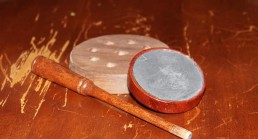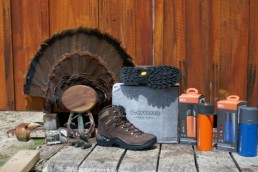Forgotten Calls: Bring Your Old Calls Back to Action
SHARE THIS POST
I was digging through a small chest my mother had given me when I first started hunting. I was looking for an old wingbone caller. The call was at the bottom of the chest, of course. I grabbed it and placed it on my lips, slightly off-center to the right, cupped my hands on the “trumpet” end and pulled some air through the call. Like riding a bicycle, I hadn’t forgotten how to work it.
After five minutes of practice—and my wife begging me to stop—I had the pitch and cadence perfect. I’d be ready for any old tom the next go-round. I looked on the floor at all the things pulled from the chest while searching for the wingbone. Old turkey calls were scattered everywhere. I had spent a fortune over the years.
I picked up several of the calls and thought of the different gobblers that have fallen victim to each. They all sound sweet, but I’ve laid them aside and over time have forgotten them. I thought: How many of these calls are like the old wingbone call and could be put back into action?
I bet you’re the same way, and have probably accumulated a good stash of turkey calls. How many have you laid to the side? You should consider doing what I’ve decided to do: clean and condition them, and practice and put them back into use.
Most old calls can’t be bought off the shelf anymore. And most sporting goods stores sell modern calls, or the “latest and greatest.”
The newbies to turkey hunting won’t have old-school calls. These are treasures that you possess. Your calls brought back into action may have the sound which a big old 4-year-old bird hasn’t heard, and will be enough to lure him within your shotgun’s range.
Let me tell you about a few old calls like the ones I had laid aside. These can give you the edge on educated toms that have “heard it all.”
The wingbone
The wingbone is the oldest turkey call man has used. The NWTF says it’s the original turkey call used by American Indians to put turkey dinners over the fire. Their Winchester Museum houses the oldest known wingbone call dating back 4,000 years. The wingbone was the most common turkey call used until the 1960s when other calls became popular.
My old wingbone isn’t thousands of years old; it was made in the ‘70s from a harvested wild turkey. There’s not much maintenance required for these. I wiped mine off and rinsed the inside with cold water. My only improvement was adding a lanyard.
The wingbone is great for yelping, cackling, cuts, clucks, purrs and the kee-kee—a sound that’s distinct and has a unique pitch. It’s a great locater call, and most times a gobbler can’t resist answering, especially the first time he hears it.
If you don’t own a wingbone call and want one, don’t fret. You can buy them online. They’re still made today, costing under $20 for the basic no-frills call. A good number are by call-makers with hand-painted designs showing off their craftsmanship and American hunting traditions.
It will give you great pleasure calling a tom in with your wingbone call.
Slate pot calls
There’s nothing like old slate sitting in a seasoned wood pot. These calls are round and flat like a pancake, usually around 4 inches in diameter and about an inch thick. Most old slate pots were not mass-produced, but were made like custom calls are made today, featuring good wood and good slate.
Take your old slate and condition it with very fine grit sandpaper; sand it in one direction. After this, finish it off by using a scouring pad. You can find this at hardware stores. Cut it in 3-inch squares and keep some with you when hunting. You won’t need to use sandpaper often. If your slates do start to sound dull, restore it with the scouring pad. Clean the end of your striker with this as well. It’s not recommended to use any sandpaper on the striker.
If you want to get a different sound out of your old slate, then mix it up with a new striker. Work it with strikers you already have that came with any recently purchased pot calls. You can also buy strikers from suppliers—try the laminates, exotic woods or even a carbon striker. It may surprise you at the new sound you can get from old slate.
Are you enjoying this post?
You can be among the first to get the latest info on where to go, what to use and how to use it!
Old box calls
Most old boxes were made from tight grain cedar or walnut and were double-sided. If you’ve inherited an old box that’s been passed down in your family, then consider yourself lucky. These are a real treasure. Old boxes won’t go bad if they’ve been kept from moisture, but they may need a little maintenance.
Use the same fine grit sandpaper and scouring pad as we did on the slate call. Take the sandpaper and clean the calling rails on the bottom (trough). Don’t sand it hard. Just clean it. Do the same for the bottom of the lid (paddle). Finish cleaning it with the scouring pad—both the calling rails and the paddle.
It’s time to chalk-it-up. You’ll need chalk sold by a call company, typically a blue or red chalk. It’s different than regular chalk used on blackboards and sidewalks, as it’s drier and has no oil. Start out with a little. Chances are it shouldn’t take much. You can add more if needed. Chalk the calling rails and the bottom of the paddle.
Try it out and see how it sounds. Hopefully, this is all you will need to do. But if you’re not happy with the tone, there is something else you can try.
Sometimes the screw that is the hinge for the paddle will back out. The calling rails on the box’s trough are usually curved. Hold the box out so you can see where the lid sits on the rails at rest. It should rest in the middle. If it sets off-center toward the unhinged end, then the screw has backed out some. Tighten it to bring it back close to center.
Tightening or loosening the lid screw will change the tone of the box. Play with it until you get the best sound from your call.
Trough calls
Trough calls are friction calls and have a strip (usually slate, aluminum or copper) that sits in a wooden trough. Mine is a Ben Lee Super Hen aluminum I bought in the ‘80s. Whichever you have or can find, they’ll condition pretty much the same as a pot call. Use the fine grit sandpaper and scouring pad on the strip. You won’t need to sand these much, as they’ll probably only need a good cleaning.
Like the pot calls, you can swap out the strikers to get a lot of different tones and pitches. These calls are excellent for close-in hen talk, like cluck and purrs. They’re also good for yelping, cackling and can’t be beat for excited cutts. The good news is that trough calls can still be purchased today.
Snuff can calls
Most old snuff can calls are homemade from small metal cylinder snuff cans. A half-moon is cut in the lid with a piece of latex stretched across the opening, and held in place by a rubber band. It’s a simple call with a great sound. They’ve been around for years. And like the wingbone, you probably won’t see one in the vest of the modern turkey hunter. It is an excellent alternative for someone who doesn’t like to use mouth diaphragms.
Some call-makers manufacture an exact copy of a snuff can call, while most have replaced the snuff can with a wood or plastic cylinder. They may call it a tube call, but they work on the same principal. If you find one that’s been laid to the side for years, you’ll have to replace the latex and the rubber band. It should be good to go after that. These calls are great for cutting; you wouldn’t believe the volume you get from these little jewels. It can reproduce most of the sounds that a turkey makes. I’ve even heard hunters that could gobble with them.
Scratch box
Small in size and simple in design, the scratch box, also called a “coffin box,” delivers the best cluck out of any calls. It’s hard to tell the difference between the cluck of a scratch box and the real thing. It also gives a solid yelp. The pitch depends on the type wood it’s made from. Cedar, the most common, gives a high pitch, while walnut will give a deeper yelp.
These two-piece calls are usually a rectangular-shaped, hollow wood chamber with striker lip and a solid wood striker piece. Every scratch box has its own unique sound. They can still be found, but your old-time ones will have the best sounds from the good-old aged wood.
Clean the striker lip with a scouring pad and chalk the striker a little. That’s all I had to do for mine. I am definitely putting this call in my vest.
Final thoughts
Go find all your old calls, break them out and scatter them across the floor. Clean ‘em up, chalk ‘em up and practice, practice, practice. There’s no need to leave these old calls in retirement. Bring them back into some hot turkey-hunting action. If you’re a seasoned veteran, you may find that you’ve developed better calling skills since you’ve set some of these to the side. You may find that your best call has been sitting idle for too long. One warning: You may need a turkey vest with more pockets.
MWO
SHARE THIS POST
Did you enjoy this post?
You can be among the first to get the latest info on where to go, what to use and how to use it!
Andy Douglas
Andy Douglas is an avid hunter, outdoor writer, and photographer. He has been chasing whitetails, big toms, bass, and most game that can be had for over 35 years. He lives the outdoor lifestyle and is passionate about sharing with others through stories and photos. Email him at AndyDouglas.Outdoors@yahoo.com



